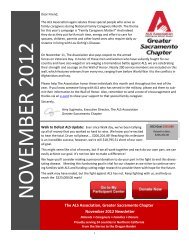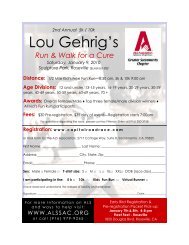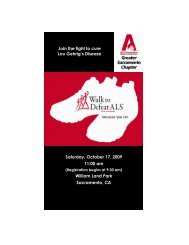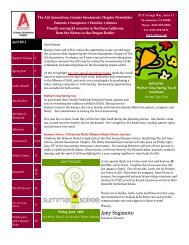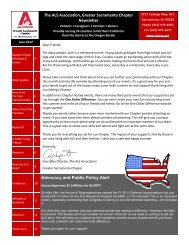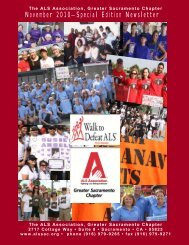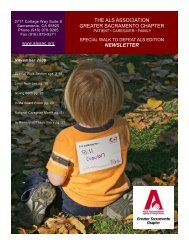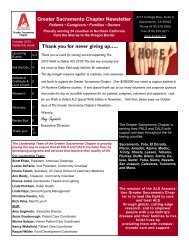Thank you to Larrie & Diane Grenz! - The ALS Association Greater ...
Thank you to Larrie & Diane Grenz! - The ALS Association Greater ...
Thank you to Larrie & Diane Grenz! - The ALS Association Greater ...
Create successful ePaper yourself
Turn your PDF publications into a flip-book with our unique Google optimized e-Paper software.
Research<br />
PAGE 11<br />
Research Indicates TDP-43 and FUS/TLS Work Together<br />
Although several new genes have now been linked <strong>to</strong> <strong>ALS</strong> including the recent exciting finding of mutations in the<br />
gene Ubiquilin-2 linked <strong>to</strong> familial <strong>ALS</strong>, exactly how these mutations cause disease remains unclear and is the focus<br />
of research in labs world-wide. Two proteins with similar structure and function, TDP43 and FUS, linked <strong>to</strong><br />
familial <strong>ALS</strong> with and without fron<strong>to</strong>temporal dementia are thought <strong>to</strong> be involved in the disease, either by causing<br />
some new <strong>to</strong>xic property or by a loss of their normal function.<br />
To identify the potential mechanism, investiga<strong>to</strong>rs led by Brian McCabe, Ph.D., assistant professor of pathology &<br />
cell biology in the Taub Institute for Research on Alzheimer’s Disease and the Aging Brain and a member of the<br />
Center for Mo<strong>to</strong>r Neuron Biology and Disease at Columbia University Medical Center used the Drosophila-fly<br />
model. <strong>The</strong>y demonstrated that these two proteins work in tandem <strong>to</strong> support the long-term survival of mo<strong>to</strong>r neurons.<br />
<strong>The</strong> findings were published in the September 1, 2011 online edition of the Journal of Clinical Investigation.<br />
<strong>The</strong> investiga<strong>to</strong>rs demonstrate that<br />
the drosophila TDP-43 and FUS/TLS<br />
proteins bind <strong>to</strong> each other, and using<br />
the mutant proteins linked <strong>to</strong> familial-<strong>ALS</strong>,<br />
they show that these proteins<br />
work <strong>to</strong>gether in a common genetic<br />
pathway. <strong>The</strong>y show that<br />
FUS/TLS mutant Drosophila can be<br />
fully rescued by wild type human<br />
FUS/TLS but not familial <strong>ALS</strong> mutant<br />
versions. Finally they show that over<br />
expression of FUS/TLS can effectively<br />
rescue TDP-43 mutants. <strong>The</strong>ir<br />
results argue that loss of a common<br />
molecular activity that requires TDP-<br />
43 and FUS/TLS could contribute <strong>to</strong><br />
<strong>ALS</strong>, in contrast <strong>to</strong> current models<br />
suggesting <strong>to</strong>xic accumulation.<br />
“<strong>The</strong> two genes make proteins with<br />
similar form and function, which suggested<br />
<strong>to</strong> us that they could work<br />
<strong>to</strong>gether, and that disruptions of either<br />
gene would affect neuronal survival,”<br />
said Dr. McCabe, who was<br />
awarded his first grant for <strong>ALS</strong> research<br />
from <strong>The</strong> <strong>Association</strong>. “I am<br />
very grateful <strong>to</strong> <strong>The</strong> <strong>ALS</strong> <strong>Association</strong><br />
for my first <strong>ALS</strong> grant on <strong>ALS</strong>2,<br />
which set us off on this path,” added<br />
Dr. McCabe.<br />
“Understanding how these two proteins<br />
cause disease is critical for<br />
therapeutic development. Further<br />
studies <strong>to</strong>gether with this new finding<br />
will provide the necessary clues <strong>to</strong><br />
help intervene and develop appropriate<br />
treatments," commented <strong>ALS</strong><br />
<strong>Association</strong> Chief Scientist Lucie<br />
Bruijn, Ph.D.




